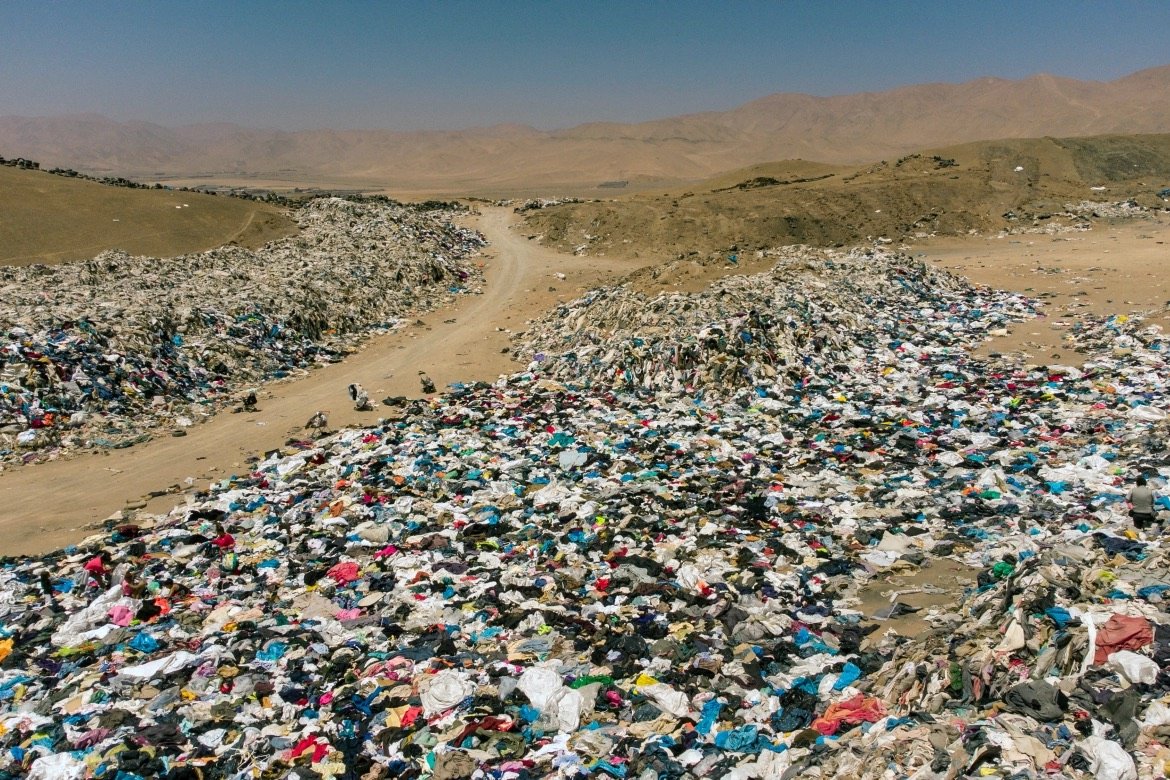Issues in the virgin synthetic supply chain
Fashion’s continued reliance on synthetic materials made from fossil fuels is exacerbating the climate crisis.
The first fossil fuel derived synthetic material was invented in 1938. Nylon, invented to be both strong and fine, was first used to produce women’s hosiery, which was previously made of more expensive and easily ripped silk.
The long-lasting, sturdy nature of nylon was revolutionary at the time, but today it is time for us to move on from such materials, for the sake of our shared planet.
Image: A 10 metre tall leg, advertising nylon hosiery in Los Angeles // Hagley Museum and Library.
Today, as much as 69% of all fashion materials are synthetics made from petrochemicals.
This number is growing. Petrochemicals are chemicals derived from petroleum, also called crude oil, which is a fossil fuel.
Fossil fuel extraction is the leading cause of the climate crisis, with the Intergovernmental Panel on Climate Change calling for an urgent phase out of fossil fuels.
The IPCC, an intergovernmental body of the United Nations, has also stated that in order to halt further global warming, all new planned fossil fuel infrastructure must be cancelled, and we must move towards renewable energy sources.
This not only impacts the energy which powers fashion supply chains, but the materials fashion uses. Fashion must work to move beyond the use of virgin fossil fuel materials as fabrics.
Fossil fuel extraction for fashion contributes to the climate crisis, which harms us all.
-

Planet
Producing fabrics from fossil fuels which must be extracted from the Earth results in major greenhouse gas emissions and pollution. Producing these materials also requires high levels of energy.
Producing plastic textiles such as polyester uses an estimated 342 million barrels of crude oil each year.
If we do not curb the climate crisis, the planet and all life on it will be devastated, entire ecosystems could collapse. We cannot change this future without addressing fossil fuels.
-

Humans
Many fossil fuel-derived synthetic materials can be considered ‘conflict materials’. Crude oil has fuelled international conflict for decades, reported as a leading cause of war.
What’s more, the public health hazards tied to fossil fuel extraction pollution disproportionately impact Asian, Black, Brown, Indigenous and low income communities: this is environmental racism.
If the climate crisis worsens, we will see a rise in climate refugees.
Image: Photo: Native American protesters opposing fossil fuels / Tannen Maury/ European Pressphoto Agency
-

Other animals
The climate crisis which fossil fuel extraction so significantly contributes to has resulted in species vulnerability, threat, endangerment and even extinction.
Population declines for different species harm biodiversity, but they also represent the major suffering of individual animals, too. When the natural environment is harmed by the climate crisis, non-human individuals are some of the first to suffer and die.Image: Kerstin Langenberger
Fossil-fuel based synthetic materials are not biodegradable, and shed polluting microfibres when they are washed.
When we wash our clothes, microscopic fibres shed off of them, and are released into waterways through our washing machines. Research suggests that at least 14 million tonnes of micro plastics have accumulated on the floor of the global ocean, with more accumulating each year.
It’s important to note that not only synthetic materials, but many treated materials — from wool to cotton — can shed microfibres which pollute the ocean.
Fossil fuel-based synthetics cannot biodegrade on land either, filling landfills with plastic which can take as long as 200 years to decompose.
The ever increasing fast pace of fashion is possible because of our use of harmful and cheaply made synthetics.

Today, the fashion industry produces billions of garments per year, as though they were disposable.
Fashion’s ‘throwaway culture’ is directly tied to the rise of cheap synthetic materials and global supply chains built on exploitative labour.
Unsold, unworn clothes dumped in a Chilean desert to slowly degrade, releasing methane emissions.
Image: Martin Bernetti // AFP
We need to help the fashion industry slow down and move towards more sustainable materials. We all have a part to play.

Want to help move both fashion and our broader system beyond using fossil fuels? Join us in endorsing the Fossil Fuel Non-Proliferation Treaty.
Want to keep learning?
-

Greenhouse gas emissions
Not only synthetic materials contribute to the climate crisis, but animal-derived materials, too. Greenhouse gases like methane cause immense harm to the planet.
-

Microfibre pollution in fashion
Research has shown that our understanding of microfibre pollution must evolve. Many fibres can contribute to this issue, especially when non-biodegradable dyes are used.
-

Total ethics alternatives to leather
Both animal-derived and fossil fuel-derived synthetic leather must be evolved beyond. While not all alternatives are perfect yet, some great leather-like options exist today.



